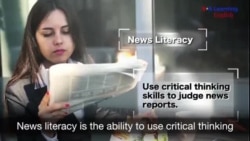Today we are at the Newseum in Washington D.C. – where the history of free expression is explained and defended.
The first printing presses arrived in the United States in the mid-1600s, marking an important step in the history of America’s free press.
A free press is important in democratic society. It allows citizens to speak freely and criticize the country's leaders without fear. Some journalists have even lost their lives for that right.
But, it can also lead to news that is false. Last year, a fake news story about a Washington pizza restaurant went viral, causing a gunman to open fire at the business.
One of the most common terms we hear today is “fake news.” The public and politicians use it to talk about the news reports they do not think are accurate.
While people have paid much attention to the term in recent years, the problem is not new. False news reports have been around since modern journalism started.
Today, information moves around us in many forms, every hour of every day. Even if we do not seek out news on our own, we often receive it anyway, instantly, on our phones.
So how can we manage this mountain of information so that fake news does not mislead us?
We believe this requires news literacy. News literacy is the ability to use critical thinking skills to judge news reports. Are they credible? Can you rely on the reports to be true?
We use real media examples to teach useful skills and methods to recognize journalism over other kinds of information. We examine the differences between facts and what people report in the media as truth.
The course provides tools to identify real and reliable news sources. And, it demonstrates ways to separate news from opinion.
Professors at Stony Brook University in New York created the News Literacy education program. We will share it with you in simple English on VOA Learning English.
The need for news literacy is possibly greater now than ever before. Learning this important skill can give us the power to take full control of our own search for the truth.
Because as we’ve seen many times before, some news presented as truth can actually turn out to be completely false.
This lesson is based on the News Literacy course at the Center for News Literacy at Stony Brook University. For more information on how to become a news literate citizen, go to The Center for News Literacy.
_________________________________________________________________
Words in This Story
fake - adj. not true or real
accurate - adj. free from mistakes or errors
mislead - v. to cause someone to believe something that is not true
consumers - n. people who buy things
media - n. television, newspapers and other sources of information
reliable - adj. able to be trusted to do what is necessary











